TOP 5 BIGGEST SHARKS
5.Great Hammerhead Shark - 20 Feet
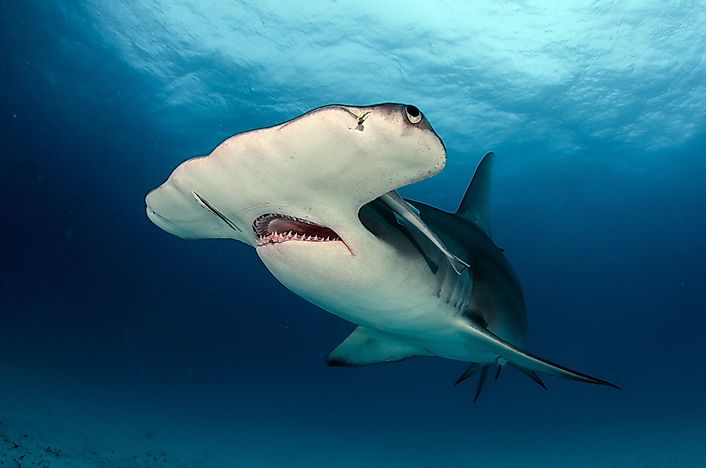
Possibly one of the most known sharks around, the Great hammerhead sharks obtains its name from the flat, T-shaped snout that makes it stand out. Its eyes are wide-set to enhance its visual range. In addition, its head is covered by ampullae of lorenzini to improve its preying ability.
The great hammerhead shark can grow up to 5.5 meters long and weigh 450 kilograms. Its coloration can range from grey-brown to green on the dorsal fins, and cream-white on its ventral sides. Its teeth are jagged and triangular. The Great Hammerhead Shark is carnivorous, feeding on crabs, squids, other sharks, herrings, sardines, jacks, guitar fish, sting rays and eagle rays. They hunt twice a day around dawn and dusk.
Great Hammerhead Sharks can be spotted near the shoreline as well as in the deep seas. They prefer tropical or temperate seas but can also survive in sandy plains, estuaries, coral and rocky reefs, open ocean, polar seas as well as in intertidal waters. They have also been spotted in fresh waters.
4. Tiger Shark - 24.3 Feet
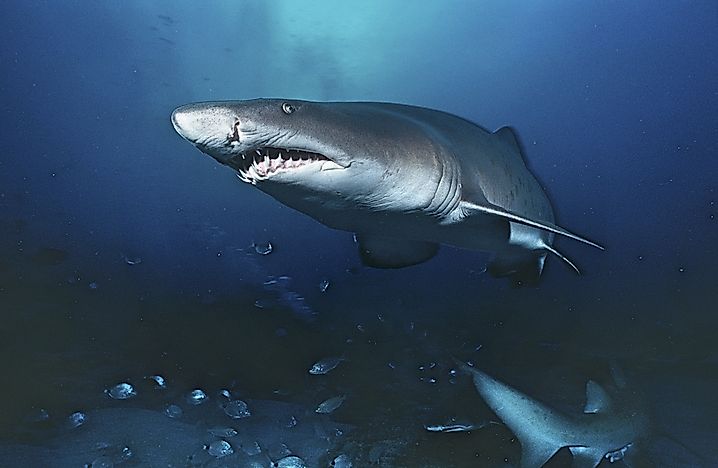
Also known as sea tiger, the tiger shark is the only living species of the genus Galeocerdo. Its complete scientific name is Galeocerdo cuvier. One of the largest sharks in the world, an adult tiger shark can measure up to 7.5 meters long and weigh over 600 kilograms. Tiger shark obtains its name from the bands of dark stripes on it skin that are similar to those of a tiger. However, these bands fade with age. Its fusiform body has blunt nose at the tip of a narrow snout. The tail’s upper lobe is larger than the lower lobe. Its mandible has serrated teeth that are crucial for breaking hard shells.
The tigers shark inhabits tropical and subtropical oceans, mostly in latitudes between 45 degrees north and 32 degrees south. It is fond of the waters of North Americas east coast all the way to the coast of Brazil as well as the Gulf Coast.
The tiger shark is carnivorous, feeding mainly on mollusks, other fish, sea turtles, crustaceans, seabirds as well as dugong. It also scavenges on dead whales. Thanks to their enormous appetite, tiger sharks eat pretty much everything on their path.
3. Great White Shark - 26. 2 Feet
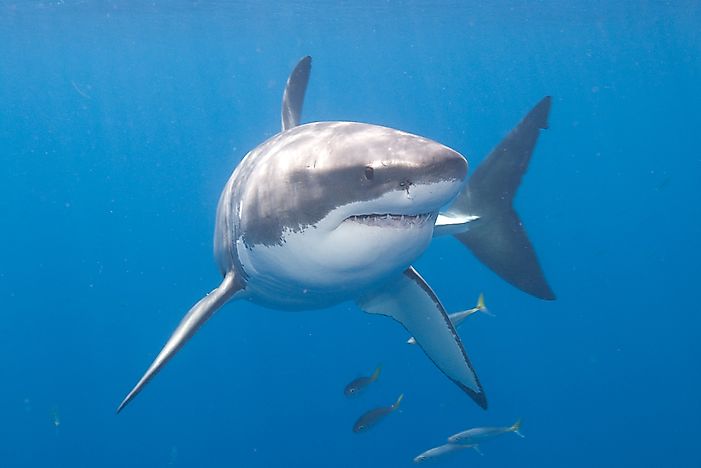
The legendary great white as it is commonly known is one of the fiercest ocean predators. A member of the Chondrichthyes class, the great white shark has earned its reputation as a “man-eater.” Its robust and fusiform body can measure up to 7 meters in length and weigh 3,500 kilograms in adulthood. Scientifically known as Carcharodon carcharias, the great white has a pointed narrow snout, two pectoral fins, a crescent-shaped caudal fin and a triangular dorsal fin. Its mouth can open up to 1.2 meters wide and has several rows of sharp, serrated teeth.
The great white has a very extended habitat area, ranging from latitudes 60 degrees north to 60 degrees south. It inhabits both temperate as well as tropical coastal waters. It commonly dwells in the coast of North America, from Newfoundland to southern Mexico. It also inhabits the waters of South Africa.
The great white is a carnivorous shark, largely feeding on smaller marine animals such as rays, squids and other fish. Adult sharks also feed on seals, other sharks, dolphins, sea lions as well as whale carcasses. Males attain sexual maturity at nine years while females become sexually mature between 13 and 15 years.
2. Basking Shark - 40.4 Feet
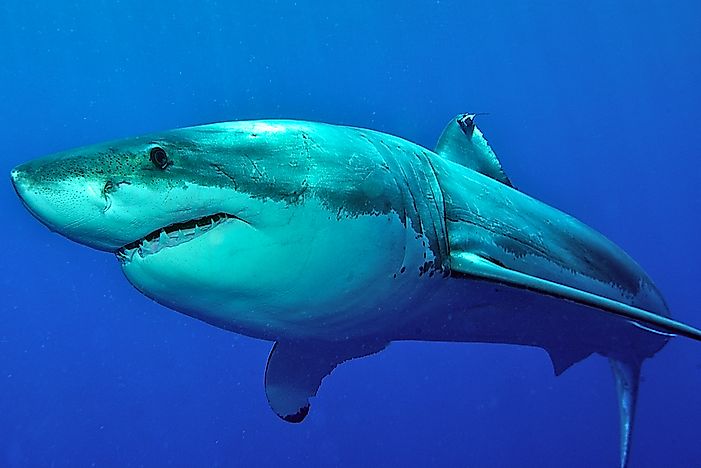
The second largest shark in the world, the basking shark, belongs the order Lamniformes. Like the whale shark, the basking shark is also a planktivorous shark. Scientifically referred to as Cetorhinus maximus, the most noticeable feature of this shark is its mouth which can open up to be one meter wide. Its conical body is covered by a mucus layer with a brown or grey skin on the back and a white belly. Its pectoral and dorsal fins are quite large as they can stretch up to two meters wide. The shark’s squalene rich liver is about one-quarter of its body weight and is crucial in helping the shark to float. An adult basking shark can weigh up to 6,000 kilograms and measure 8.8 meters.
While the basking shark inhabits all the oceans of world, it is predominant in the temperate sub-polar waters and the continental shelf. Its habitat is largely influenced by availability of food. During summer, it migrates to coastal areas to feed on copepods. However, as soon as winter sets in, it moves back to cold temperate waters.
1. Whale Shark - 41.5 Feet
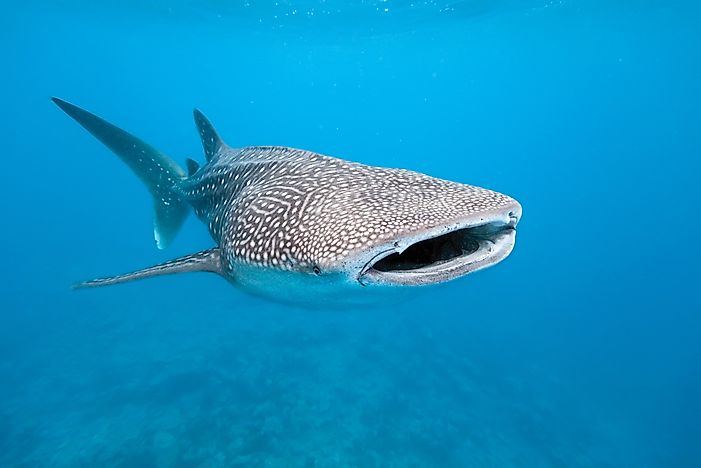
Growing up to 20 meters long and weighing 12,500 kilograms, the whale shark is without a doubt the largest shark in the world. Its fusiform body is broad in the mid-section and narrows in the head and tail. The head is wide and flat with tiny eyes on the front. The mouth is located at the tip of the snout. With 300-350 rows of teeth and ten pairs of pads for filtering food, whale shark’s mouth can open about 1.5 meters. Like most pelagic sharks, whale shark has one pair of pectoral fins, one pair of dorsal fins and a caudal fin. It has a blue-grey colored back and a white belly.
Whale shark’s extensive distribution covers all the tropical and temperate seas of the world, except for the Mediterranean Sea. They dominate waters in the latitudes between 35 degrees south and 30 degrees north in countries such as Australia, South Africa, Ecuador, Mexico, the Philippines and Belize.
Reaching sexual maturity at around 25 years, whale sharks mainly feed on plankton, although they occasionally prey on small creatures like jellyfishes, krill, squids, anchovies, crabs and sardines. They mainly feed by suction and filtration.
No comments:
Post a Comment